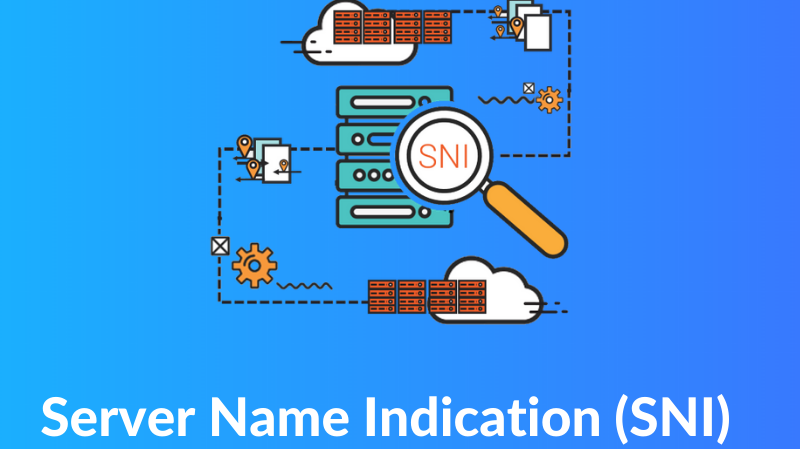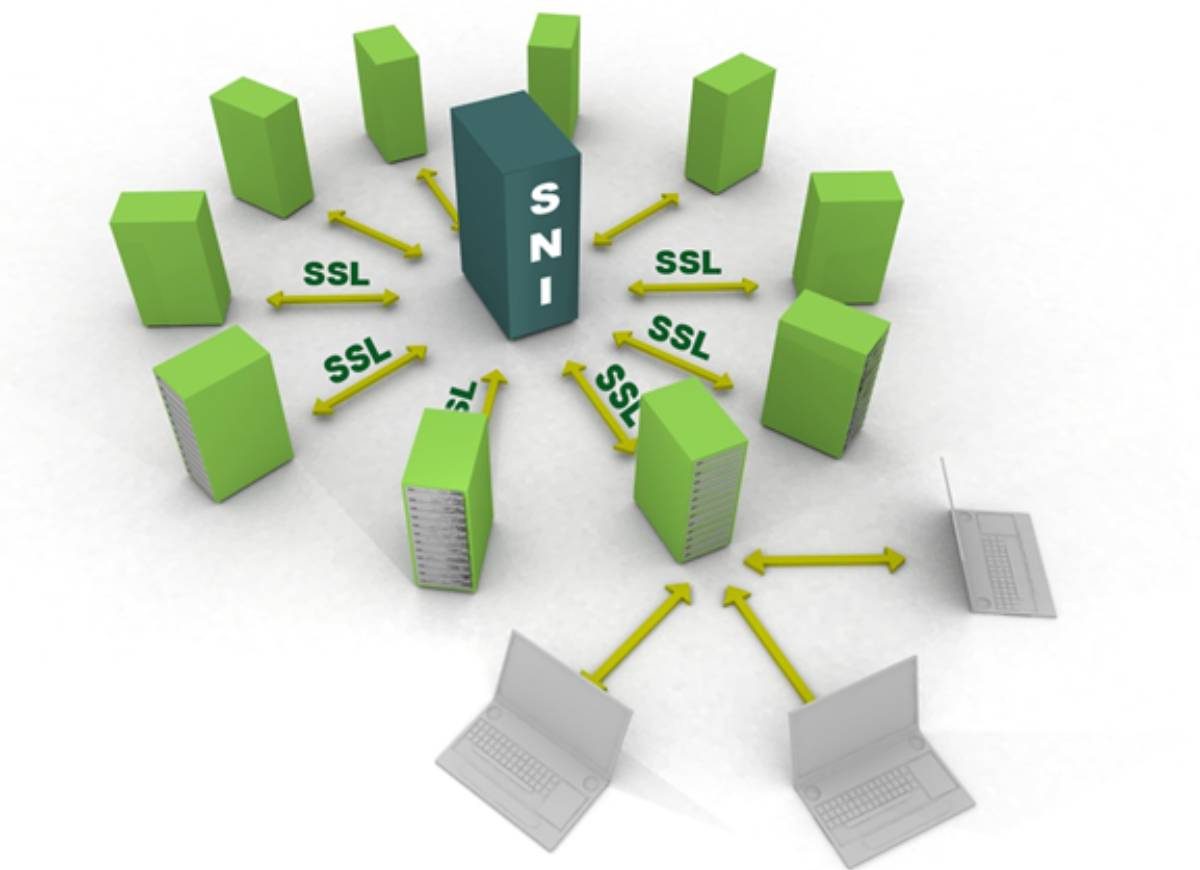What is SNI? Uses of TLS extension in SNI
 What is SNI? Uses of TLS extension in SNI Picture 1
What is SNI? Uses of TLS extension in SNI Picture 1
Server Name Indication allows a web server to recognize the domain name that a browser is requesting to connect to, thereby creating the appropriate SSL/TLS connection. In this article, we will learn with TipsMake what is SNI? its terms of use and its uses.
What is SNI?
SNI (Server Name Indication) is an extension of the TLS (Transport Layer Security) protocol, developed on top of the SSL (Secure Sockets Layer) standard. Its main purpose is to allow multiple SSL certificates to coexist on a single IP address. Before SNI was born, each SSL certificate needed a separate IP address to operate, which was difficult to manage and resource-intensive.
 What is SNI? Uses of TLS extension in SNI Picture 2
What is SNI? Uses of TLS extension in SNI Picture 2
What is SNI?
SNI is a method that allows a web server to simultaneously identify multiple domains using a single IP address. When a browser sends a connection request to the server, information about the domain is sent along with it, helping the server choose the correct SSL certificate for that domain.
Conditions for using SNI
Although SNI offers many benefits, not all systems support this technology. Here are some prerequisites for using SNI effectively.
Web server support
To implement SNI, the web server must be configured to support this functionality. Many modern server software such as Apache, Nginx, or IIS have built-in SNI functionality. However, for older versions, the server administrator may need to update or change the configuration to enable SNI.
Browser compatibility
Modern browsers such as Chrome, Firefox, Safari, and Edge mostly support SNI. However, if users are still using an outdated browser, they may encounter problems accessing websites that use SNI.
Correct DNS configuration
For SNI to work properly, the DNS configuration must also be correct. The domain name must be correctly pointed to the IP address of the server where the SSL certificate is hosted. If the DNS configuration is incorrect, users may be redirected to an unwanted server or one that does not have the appropriate SSL certificate.
Uses of SNI
Below are some of the outstanding uses of SNI:
Cost savings
One of the biggest benefits of SNI is the cost savings it can offer businesses. Instead of having to purchase multiple IP addresses for each domain, organizations can use a single IP address to host multiple domains and SSL certificates.
Enhanced security
SNI plays an important role in enhancing the security of websites. By using SNI, users can rest assured that their personal information is better protected through a secure SSL/TLS connection.
Improve performance
SNI helps improve the performance of web services by reducing the time required to establish an SSL connection. When a browser sends domain information via SNI, the server can quickly determine the certificate required for the connection without having to perform multiple verification steps.
Uses of the SNI TLS extension
Personal Information Security
The SNI TLS extension enables encryption of information between the browser and the server, ensuring that data is not leaked or stolen during transmission. Thanks to this protection, users can freely share personal information without worrying about being tracked or attacked remotely.
 What is SNI? Uses of TLS extension in SNI Picture 3
What is SNI? Uses of TLS extension in SNI Picture 3
Uses of the SNI TLS extension
Multi-domain service support
One of the important applications of the SNI TLS extension is support for multi-domain services. The SNI system allows businesses to easily manage SSL certificates for multiple domains without having to deploy multiple servers.
Develop and apply new technology
SNI is not just a temporary solution but also opens up many opportunities for the development of security technology in the future. Further improvements in the field of encryption and information security will certainly be based on the solid foundation that SNI provides.
What is Hostname and Virtual Hostname?
Hostname and Virtual Hostname are two important concepts in network architecture, related to storing and accessing data on the internet. Understanding them will help you apply technologies like SNI more effectively.
What is Hostname?
A hostname is a unique name assigned to a device on a network that allows users to easily identify and access that device. For example, when you visit a website, the hostname is the domain name you type into your browser.
Hostnames are often used to look up a corresponding IP address on the network. When a user types a hostname into a browser, a DNS request is sent to look up the IP address corresponding to that hostname.
What is Virtual Hostname?
Virtual Hostname is a term used to describe a configuration that allows multiple domain names to be hosted on the same IP address. In this configuration, the server uses information from SNI to determine which domain name is being requested and then selects the appropriate SSL certificate. Virtual Hostname makes server management more flexible and convenient, while also saving costs for businesses.
Difference between Hostname and Virtual Hostname
Although both involve identifying and managing IP addresses on a network, hostnames and virtual hostnames have important differences. Hostnames typically uniquely identify a device or service, while virtual hostnames allow multiple domain names to coexist on a single IP address.
This distinction is essential in today's business environment, where managing multiple brands and products has become a necessity. Thanks to virtual hostnames, businesses can save costs and optimize server system performance.
What is Encrypted SNI?
Encrypted SNI is a newer concept in the field of network security, which aims to better protect user information during data exchange. It is an extension of traditional SNI technology, which encrypts SNI information before sending it to the server.
One of the biggest problems with traditional SNI is that the domain information that users send to the server can be tracked or logged by third parties.
Encrypted SNI is increasingly being adopted by many organizations and businesses, especially those that require a high level of security. The development of this technology will certainly promote the security trend in the network field, creating a safer environment for users when accessing the internet.
What happens if the user's browser does not support SNI?
If your browser does not support SNI, accessing websites that use SNI can cause some serious problems. Here are some things to keep in mind.
Unable to establish SSL connection
If the browser does not support SNI, when a user attempts to access a website that uses SNI, the server may not recognize the domain name the browser is requesting. As a result, the user may receive a security warning from the browser, stating that the connection is insecure or unauthenticated.
Reduced user experience
Not supporting SNI can result in a poor user experience. Users may be frustrated by security warnings or unable to access services they need.
Impact on business revenue
For businesses, customers being unable to access online services due to browsers not supporting SNI can be devastating. Customers may leave the site and look for other options, resulting in lost revenue and reduced conversion rates.
Conclude
SNI is an important technology in today's network security world. It not only allows multiple SSL certificates to exist on a single IP address, but also helps save costs, increase security, and improve the performance of web services.
Based on the knowledge presented in the article, we can clearly see that SNI not only contributes to protecting users' personal information but also promotes the development of new security technologies such as Encrypted SNI.
You should read it
- What is special about Light Phone 2, a smartphone that helps smartphone users?
- Mistakes caused the wound due to ants burning three long burning chambers
- What gifts for your wife on International Women's Day 8/3?
- What chance for Edge to overcome Chrome becomes the standard browser for businesses
- How to connect laptop to TV? 5 ways to connect the TV to laptop
- First laptop to use 'the fastest chip on the planet'
- 9 things to note about memory cards
- Hazards from shortened links and prevention
- Fix GameLoop error without Google Installer
- How to Install Mumble on Ubuntu
- How to Trailer a Horse
- Instructions to copy data from Excel to Word retain the format
May be interested

Between OLAP and OLTP: Which System is Best?

How to Set Up Centralized Log Monitoring with ELK Stack / Graylog / Splunk

Red Team vs Blue Team: How to Simulate Server Attacks and Effective Defense

1kb equals how many bytes

What is TFTP? Detailed instructions on how to use TFTP Client in Windows

What is DHCP and Static IP? Should I choose DHCP or Static IP?






 Instructions on how to use action extension on iPhone and iPad
Instructions on how to use action extension on iPhone and iPad Top 6 best VPN add-ons 2023
Top 6 best VPN add-ons 2023 5 ways to identify safety extension before installation
5 ways to identify safety extension before installation Instructions for using extension share (sharing) on iPhone and iPad
Instructions for using extension share (sharing) on iPhone and iPad Top 5 best VPN extensions for Mozilla Firefox 2021
Top 5 best VPN extensions for Mozilla Firefox 2021 What is file extension?
What is file extension?